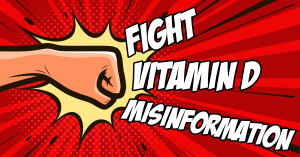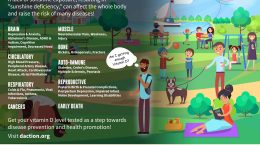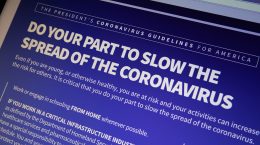Published on August 24, 2022
What these authors defined as vitamin D misinformation is damaging to public health, and may come as a shock to our audience. Dr. William Grant responds to this recent publication on vitamin D ‘misinformation’…
Key Points
- Authors of a paper claimed that, out of the 77 videos that they reviewed and analyzed, “over three-quarters of them contained misleading content about COVID-19 and vitamin D.”
- According to Dr. William Grant, “Clearly, scientific evidence supports most of what Quinn and colleagues consider misleading information”
- Science has demonstrated the roles vitamin D plays within the immune response that are especially influential in fighting COVID-19 – the truth about vitamin D and its need for health must not get buried due to misinformation articles such as this one!
 A paper by Quinn et al., titled “COVID-19 and Vitamin D Misinformation on YouTube: Content Analysis,” states in the background section of their abstract:
A paper by Quinn et al., titled “COVID-19 and Vitamin D Misinformation on YouTube: Content Analysis,” states in the background section of their abstract:
“The “infodemic” accompanying the SARS-CoV-2 virus pandemic has the potential to increase avoidable spread as well as engagement in risky health behaviors. Although social media platforms, such as YouTube, can be an inexpensive and effective method of sharing accurate health information, inaccurate and misleading information shared on YouTube can be dangerous for viewers. The confusing nature of data and claims surrounding the benefits of vitamin D, particularly in the prevention or cure of COVID-19, influences both viewers and the general “immune boosting” commercial interest.”
They state in their paper that, out of the 77 videos that they reviewed and analyzed, “over three-quarters of them contained misleading content about COVID-19 and vitamin D.” But, what did they use to define information as misleading?
What do they define as Risky Health Behaviors, Inaccurate and Misleading Vitamin D Information?
Dr. William Grant has written an official response to the authors of the Quinn et al. paper, focusing on their lack of understanding of the current knowledge of vitamin D, and what is now known about vitamin D and COVID-19 in particular.
According to Dr. Grant, “Clearly, scientific evidence supports most of what Quinn and colleagues consider misleading information,” and “Redoing their analysis would be worthwhile for Quinn and colleagues, armed with a better understanding of what is known about vitamin D’s role in reducing risk of SARS-CoV-2 infection and COVID-19 incidence, severity, and mortality.”
Some of what the authors defined as misinformation included:
Anything discussing the role of vitamin D in boosting immune health or helping to reduce inflammation. Immune-boosting properties of vitamin D were labeled as misinformation and considered “scientifically inaccurate” by the authors. The authors only mention of the “current understanding of the important functions of vitamin D in the body” were those related to the hormonal function of vitamin D, in the regulation of calcium and phosphate homeostasis for bone health.
Learn more about the scientifically-proven roles of vitamin D in immune health and inflammation.
Suggesting vitamin D supplementation or intentional UV/sunshine exposure. As quoted by the authors, “Encouraging members of the public to purchase supplements or engage in risky health behaviors for unproven benefits is concerning to public health researchers,” and videos were labeled as misleading if they made any such suggestions. Videos that recommended vitamin D supplementation in the amount of 4000 IU or higher were especially called-out as promoting unsafe behavior, although the U.S. National Academy of Medicine (NAM, formerly the Institute of Medicine) has identified their no adverse effects level (NOAEL) at 10,000 IU/day, and studies have reported no observed toxicity with a daily vitamin D intake below 30,000 IU/day.
Learn more about vitamin D supplementation and toxicity.
Promoting “unsafe” sun or UV exposure was defined by the authors as any suggestion of intentional, unprotected sun exposure for more than 15 minutes at any time of day, as well as any exposure at mid-day without protection (when UVB rays are available to make vitamin D). There are many proven health benefits to safe sun exposure – which can include exposure to mid-day sun, without sunscreen, for extended periods of time, as long as the skin does not burn.
Learn more about the potential harms of sun exposure and how the sun can be safely used to improve health.
Any mention of the possible role of vitamin D in the prevention or cure of COVID-19. Many studies have now been published demonstrating the reduced risk of SARS-CoV-2 infection, and COVID-19 incidence, severity, and mortality. Dr. Grant reviews a few of those studies, as well as one that included vitamin D as part of a treatment protocol for COVID-19, which resulted in great reductions in disease progression and mortality.
Learn more about the many published studies on vitamin D and COVID-19.
Evidence Supports the Use of Vitamin D to Boost Immune Health and Help Fight COVID-19
Science has demonstrated the roles vitamin D plays within the immune response that are especially influential in fighting COVID-19, with additional research showing how “…low levels of vitamin D can result in dysfunction of crucial antimicrobial effects, potentially contributing to poor prognosis.” In addition
- vitamin D receptors are found in high concentrations in various immune cells that are vital to a successful immune response, especially dendritic cells, macrophages, T and B lymphocytes
- the enzyme that converts 25(OH)D3 into 1,25(OH)2D3 is present in high levels in macrophages and the epithelia of the respiratory system specifically
- and, vitamin D has been found to disrupt the function of 19 out of 27 (70%) SARS-CoV-2 proteins
Learn more about how the presence or absence of vitamin D can affect COVID-19 disease progression.
The Misinformation Needs to STOP!
Vitamin D is essential to our health, and especially to a healthy immune response. Steps must be taken by all to avoid vitamin D deficiency; unfortunately, close to 90% of the US adult population is below the recommended level of 40-60 ng/ml (100-150 nmol/L). Information such as that found in the Quinn et al. article can only further damage public health, especially in this continuation of the COVID-19 pandemic.
About Dr. William Grant
William B. Grant has a Ph.D. in physics from the University of California, Berkeley (1971). He had a 30-year career in laser remote sensing of atmospheric constituents including at NASA Langley Research Center in Hampton, Virginia. He has published landmark ecological studies related to solar UVB on cancers, influenza, autism, and to dietary links to Alzheimer’s disease, as well as the first article suggesting the likely role of vitamin D in reducing risk of SARS-CoV-2 infection and COVID-19. He is the author of 304 publications on vitamin D listed at pubmed.gov, with 21 publications regarding COVID-19, 29 of his open-access publications are available at Nutrients. His main interest now is the study of vitamin D in reducing risk of chronic and infectious diseases.
Learn more about Dr. Grant here.
Vitamin D is an Easily Modifiable Factor to Help Improve Disease Outcomes – What Vitamin D Level do YOU Have?
Don’t ever consider a situation too late to take steps for correcting or avoiding vitamin D deficiency. Measuring your vitamin D level and calculating a supplementation amount to help reach and maintain a target level, or taking loading doses to correct deficiency faster, could possibly make all the difference in how a current disease situation progresses. Test your level now!
Create your custom home blood spot kit by adding any of the following measurements, along with your vitamin D:
- Omega-3 Index (with or without Ratios)
- Magnesium (with or without additional Elements – copper, zinc, selenium, mercury, cadmium, lead)
- hsCRP as a marker of inflammation and HbA1c as a marker of blood sugar health, two other important factors influencing prenatal conditions
Having and maintaining healthy vitamin D levels and other nutrient levels can help improve your health, now and for the future. Enroll and test your levels today, learn what steps to take to improve your status of vitamin D (see below) and other nutrients and blood markers, and take action! By enrolling in the GrassrootsHealth projects, you are not only contributing valuable information to everyone, you are also gaining knowledge about how you could improve your own health through measuring and tracking your nutrient status, and educating yourself on how to improve it.






